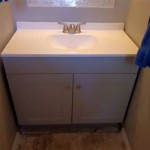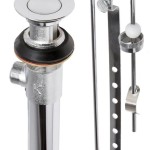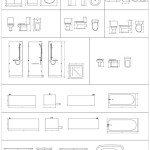How To Fix A Leaking Wall Mounted Bathroom Faucet
A dripping wall-mounted bathroom faucet can be a persistent annoyance and a source of wasted water. Fortunately, many common causes of leaks are relatively easy to fix with basic tools and a little plumbing know-how. This guide will outline the steps involved in diagnosing and repairing a leaky wall-mounted faucet.
1. Identifying the Source of the Leak
Before attempting any repairs, pinpoint the exact location of the leak. Is the water dripping from the spout, the handle base, or the connection between the faucet and the wall? The location of the leak helps determine the likely culprit and the necessary repair steps. A leak from the spout often indicates a problem with the cartridge or O-rings. A leak from the handle base might mean a worn-out O-ring or packing nut. Finally, leaks from the wall connection point suggest a problem with the supply lines or the faucet's mounting hardware.
Carefully inspect the faucet for any visible signs of damage, corrosion, or mineral buildup. These visual cues can provide further clues about the source of the problem. For example, substantial mineral buildup around the spout might indicate hard water issues that have contributed to component wear.
2. Gathering the Necessary Tools and Materials
Once the leak's source is identified, gather the necessary tools and materials. Commonly required items include:
- Adjustable wrench
- Phillips head screwdriver
- Flathead screwdriver
- Basin wrench (for tight spaces)
- Pliers
- Replacement cartridge (if applicable)
- O-rings (assorted sizes)
- Plumber's tape
- Penetrating oil (for loosening corroded parts)
- Old towels or rags
- Bucket
It's essential to purchase replacement parts that match the faucet's make and model. Taking the old cartridge or O-rings to a hardware store allows for a side-by-side comparison and ensures the correct replacements are obtained. This will prevent compatibility issues and ensure a successful repair.
3. Shutting Off the Water Supply
Before starting any repair work, turn off the water supply to the faucet. Locate the shut-off valves underneath the sink. There will be separate valves for hot and cold water. Turn both valves clockwise until they are completely closed. Turn on the faucet to release any remaining water pressure in the lines. This step is crucial to prevent flooding and ensure a safe working environment.
If the shut-off valves are corroded or difficult to turn, apply penetrating oil and allow it to soak for several minutes before attempting to turn them. If the valves are completely seized and cannot be turned, it may be necessary to contact a professional plumber to shut off the water supply at the main water line.
4. Disassembling the Faucet
Disassembling the faucet will vary depending on the specific model. However, the general steps often involve removing the handles. Look for setscrews underneath the handle caps. Use a small allen wrench or a flathead screwdriver to remove these screws. Once the screws are removed, the handle caps can be pulled off, exposing the handle screws. Remove these handle screws to detach the handles.
After removing the handles, the cartridge can be accessed. Use a cartridge puller or pliers to remove the cartridge. Inspect the cartridge for wear and tear. If it's damaged or worn, replace it with a new one. Also, inspect and replace any O-rings that appear worn or cracked.
If the leak is coming from the handle base, inspect the O-rings and packing nut. Replace any worn-out components. Tighten the packing nut to ensure a secure seal.
5. Reassembling the Faucet
Reassemble the faucet by reversing the disassembly steps. Apply plumber's tape to any threaded connections to ensure a watertight seal. Tighten all connections securely, but avoid overtightening, which can damage the components. Turn the water supply back on slowly and check for leaks. If any leaks are detected, tighten the connections further or re-check the replaced components for proper installation.
Regular maintenance can prevent future leaks. Periodically inspect the faucet for signs of wear and tear and replace worn-out components promptly. This proactive approach can extend the lifespan of the faucet and prevent costly repairs down the line.

How To Fix A Leaking Kohler Wall Mount Faucet

Wall Mounted Faucet Repair Is Painful

How To Fix A Leaky Wall Mounted Faucet Rbrohant

One Handle Wall Mount Tub Filler Leaking Moen Solutions
:strip_icc()/102381729-bf6543ca231b4edeafadca7eaab2ef1e.jpg?strip=all)
How To Fix A Bathroom Faucet That S Leaking

How To Fix A Leaky Faucet True Value

How To Fix A Leaky Bathtub Faucet Vintage Tub Bath

How To Fix A Leaking Faucet In The Laundry Room Family Handyman

Pivotal Wall Mount Bathroom Faucet

Kitchen Faucet Leaking At The Base Fix Your Leak In 5 Steps Kege
Related Posts







